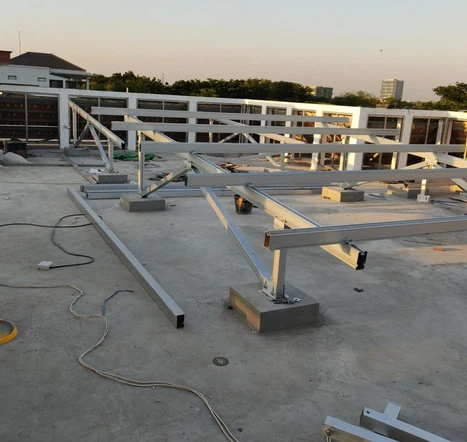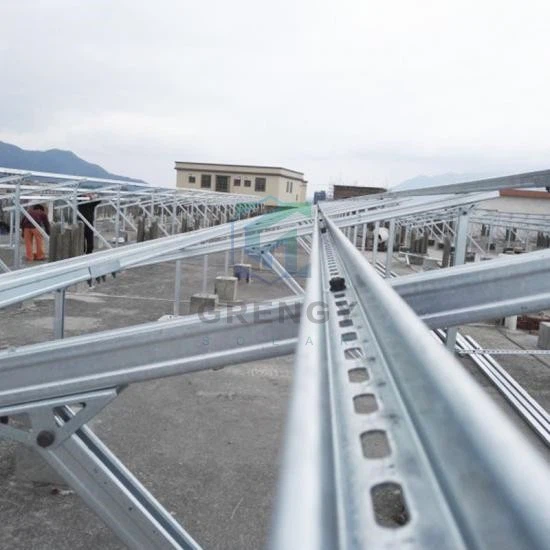Solar Panel Racking System Concrete Base
Name:Solar Panel Racking System concrete base
Max wind speed:50m/s-60m/s
Max snow load:1.4-1.6kn
Module Orientation:Portrait (preferred/cost-effective) and landscape
Module Inclination:2V / 4H: 0 - 25 degrees ;3V / 5H: 0 - 15 degrees
Purlins: ZAM S355
Rafters: ZAM S355
Support Frame: ZAM S355
Fixations: Stainless steel (SUS304) *(SUS316) & HDG available
Warranty: 25 yrs
- Fast Delivery
- Quality Assurance
- 24/7 Customer Service
Product Introduction
1.Function:
Solar Panel Racking System concrete base serves as the fundamental support structure. Its primary function is to firmly hold the solar panel racks in place, ensuring stability against various external forces such as wind, rain, and snow. By providing a stable foundation, it enables the solar panels to maintain their optimal position for maximum sunlight capture throughout the day, thus enhancing the overall efficiency of the solar power generation system.
2. Design Considerations
2.1 Load - bearing Capacity
The design of the concrete base must account for the weight of the solar panels, racks, and any additional equipment, as well as potential live loads like wind and snow. Engineers need to calculate the maximum forces that the base will endure based on local climate data and the specific characteristics of the solar installation. For example, in areas with high - wind speeds, the base needs to be designed to withstand strong uplift and lateral forces.
2.2 Soil Conditions
The properties of the soil where the concrete base is to be constructed play a crucial role. If the soil has low bearing capacity, measures such as increasing the base area or using deep - foundation techniques might be necessary. Soil moisture content and its potential for expansion or contraction also need to be considered to prevent the base from cracking or shifting over time.
3. Construction Process
3.1 Site Preparation
Before construction, the site needs to be cleared of any debris, vegetation, and loose soil. The area is then leveled to ensure a uniform base for the concrete pour. In some cases, if the terrain has a slope, terracing or grading may be required.
3.2 Formwork Installation
Formwork is set up to define the shape and dimensions of the concrete base. It is usually made of wooden planks or steel sheets. The formwork must be strong enough to hold the wet concrete and prevent any leakage during the pouring process.
3.3 Reinforcement Placement
Steel rebars are often placed within the formwork to enhance the strength of the concrete base. The arrangement and size of the rebars are determined by the design requirements. They help to resist tensile forces that the base may experience, especially in areas with seismic activity or strong winds.
3.4 Concrete Pouring
High - quality concrete, with the appropriate mix ratio of cement, aggregates, water, and additives, is poured into the formwork. The concrete is then vibrated to remove any air bubbles and ensure proper compaction. After pouring, the surface of the concrete is finished to achieve the desired level and smoothness.
3.5 Curing
The newly poured concrete base needs to be cured properly. This typically involves keeping the concrete moist for a certain period, usually around 7 - 14 days, depending on the type of concrete and environmental conditions. Curing helps the concrete reach its full strength and durability.
4. Advantages
4.1 High Stability
Concrete bases offer excellent stability, which is essential for long - term operation of solar panel systems. They can firmly anchor the racks and solar panels, reducing the risk of structural failure due to external forces.
4.2 Durability
Concrete is highly durable and can withstand harsh environmental conditions such as temperature variations, moisture, and chemical exposure. This ensures that the solar panel racking system has a long service life, minimizing the need for frequent replacements or repairs.
4.3 Adaptability
Concrete bases can be customized in terms of size, shape, and design to meet the specific requirements of different solar panel installations, whether it's a small rooftop system or a large - scale solar power plant.
More details please contact vivi at vivian@grengysolar.com
Technical overview;

Installation overview:



Project examples:


factory loading:


Hot Tags: solar panel racking system concrete base, suppliers, factory, customized, custom, buy, Adjustable Solar Clamps, Solar Roof Mount, Stainless Steel Solar Hook, End Clamp, Solar Panel Metal Roof Clamps, Solar Panel Brackets for Roof













